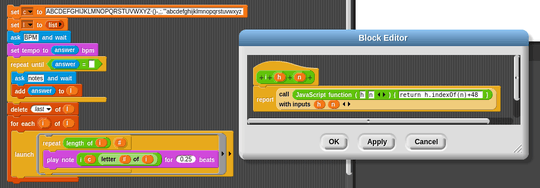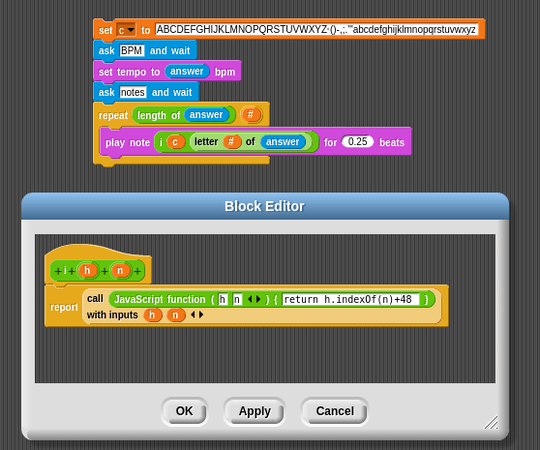JavaScript (ES6) 377 - 50 - 50 - 75 = 202
First, here's a runnable snippet that uses <input> fields instead of file-reads:
<b>BMP:</b> <input id="bpm" size=3 placeholder="BMP" value="120"> <b>Transpose:</b> <input size=3 id="transpose" placeholder="Transpose" value="0"><br/><br/><div id="tracks" style="float:left;padding-right:5px;"><input placeholder="Track" class="track"></div><button id="add">Add Additional Track</button><div style="clear:both; padding-top:5px;"></div><button id="play"><b>Play</b></button><script>f=function(s,b,z){C=new (window.AudioContext||window.webkitAudioContext);b=6e4/b;s.map(function(p){var o=C.createOscillator(t=setTimeout);o.connect(C.destination);o.start();p.split("").map(function(c,i){t(function(){o.frequency.value=440*Math.pow(2, ("ABCDEFGHIJKLMNOPQRSTUVWXYZ ()-,;.'\"abcdefghijklmnopqrstuvwxyz".indexOf(c)-21+z)/12)},b*i)});t(function(){o.stop()},p.length*b)})};document.getElementById("play").onclick=function(){f([].map.call(document.getElementsByClassName("track"),function(e){return e.value;}),+document.getElementById("bpm").value,+document.getElementById("transpose").value);};document.getElementById("add").onclick=function(){var i=document.createElement("input");i.placeholder="Track";i.className="track";document.getElementById("tracks").appendChild(document.createElement("br"));document.getElementById("tracks").appendChild(i);};</script>
And now, the actual entry:
f=(n,b,z)=>{C=new AudioContext;b=6e4/b;s=n.map(m=>(x=new XMLHttpRequest,x.open("GET",m,0),x.send(),x.responseText));s.map(p=>{var o=C.createOscillator(t=setTimeout);o.connect(C.destination);o.start();[...p].map((c,i)=>t(_=>o.frequency.value=440*Math.pow(2,("ABCDEFGHIJKLMNOPQRSTUVWXYZ ()-,;.'\"abcdefghijklmnopqrstuvwxyz".indexOf(c)-21+z)/12),b*i)),t(_=>o.stop(),p.length*b)})}
The three arguments are an array of filepath strings to play concurrently, notes per minute, and number of half-steps to transpose all inputs.
With whitespace and comments:
f=(n,b,z)=>{
C=new AudioContext;
b=6e4/b;
// fill s with the contents of each file
s = n.map(m=>(x=new XMLHttpRequest,x.open("GET",m,0),x.send(),x.responseText));
// play each track
s.map(p=>{
var o=C.createOscillator(t=setTimeout);
o.connect(C.destination);
o.start();
// queue up each note with setTimeout
[...p].map((c,i)=>
t(_=>
o.frequency.value=440*
Math.pow(2,
("ABCDEFGHIJKLMNOPQRSTUVWXYZ ()-,;.'\"abcdefghijklmnopqrstuvwxyz".indexOf(c)-21+z)/12
),
b*i)
);
// queue up termination of those track
t(_=>o.stop(),p.length*b)})
}
f(["file:///home/users/apsillers/notes.txt",
"file:///home/users/apsillers/notes2.txt"],
240, 5)


When will you be deciding the winner? – LegionMammal978 – 2015-04-08T12:54:30.303
Can we assume the input will not contain any unlisted characters? Or, what should we do when we encountered unlisted characters? – apsillers – 2015-04-08T14:09:22.203
@apsillers In the Snap ! answer, he said that he'd allow undefined behavior. – LegionMammal978 – 2015-04-08T14:40:49.720
I uploaded a sample; you were quite correct,it really doesn't sound any good... – Sanchises – 2015-04-08T20:45:15.323